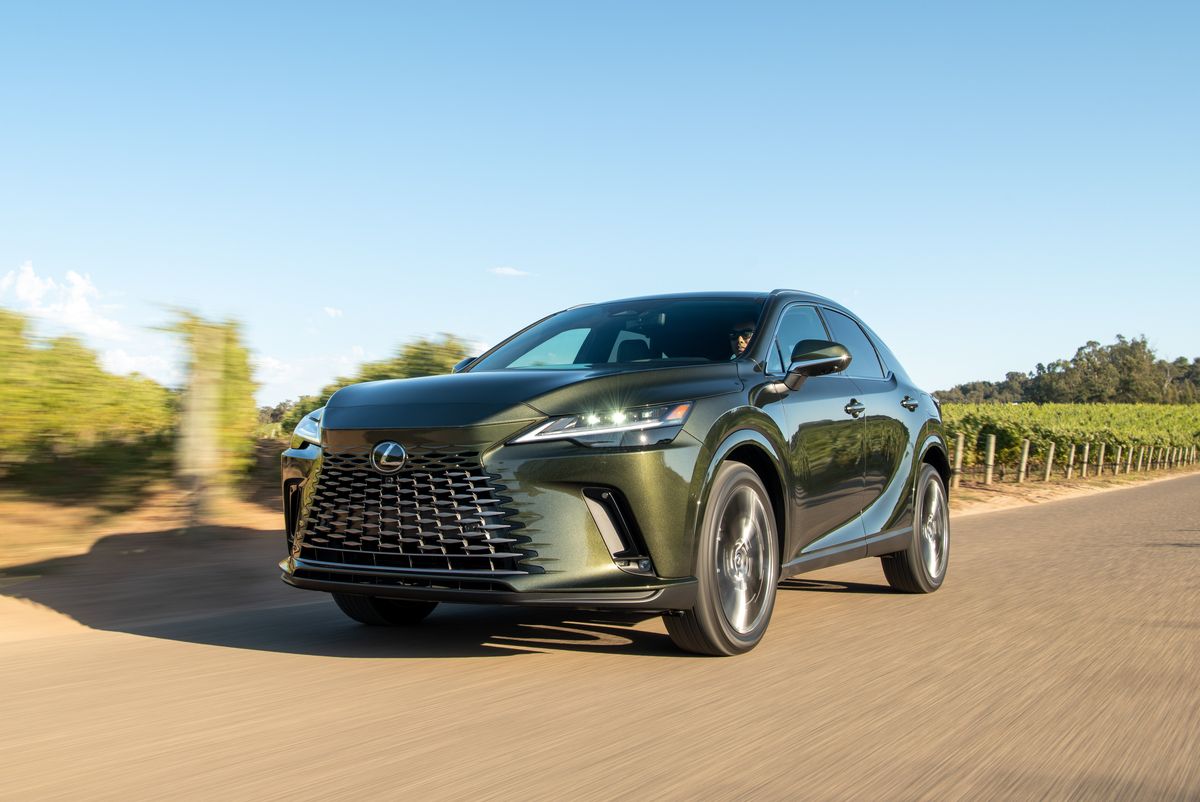The 2023 Lexus RX has been fully redesigned, but despite some changes to the underhood ingredients, it aims to bring drivers the same sense of luxury and comfort that defined its predecessors. The new SUV is available as a gas-powered RX350, an RX350h hybrid, and a higher-performing RX500h hybrid. (There’s also a plug-in-hybrid RX450h+ that will join the lineup later.)
The most noticeable change in the SUV’s styling is to the spindle grille. This design element has always been polarizing, and the new one likely will be too. Particularly, the bulging transition from the more upright trapezoidal lower section of the grille to the hood throws us off. The wheelbase is 2.4 inches longer, and the rear overhang is shorter. The previously available three-row L version gets the sack. (It’s likely to be replaced by a new model called the TX.
The RX500h represents a high-performance hybrid counterpoint, with the turbo-four engine from the RX350 and a more potent rear electric motor that combine for 366 horsepower and 406 pound-feet. We expect it’ll reach 60 mph in 5.6 seconds.
None of these RX models, though, are particularly sporty or fun to drive. Instead, Lexus puts comfort and luxury ahead of performance, the same strategy that has served the RX well for decades.
The RX350h feels unusually anemic, however, requiring you to floor the accelerator to match the flow of highway traffic. Meanwhile, the engine groans loudly as it labors and makes the RX350h feel slower than it is.
With a sizable jump in power and a conventional six-speed automatic, the RX500h doesn’t suffer as badly. It’s quicker to respond and breaks up the drone with traditional shifts. It instills much more confidence but is still no rocket, as it would get smoked by a BMW X5 xDrive40i, which reaches 60 mph in only 4.8 seconds.
Handling performance doesn’t fare any better. The soft suspension tuning doesn’t encourage spirited driving, and undulations in the road tend to produce residual rebounds after the event. The brake pedal further degrades confidence with its mushy feel and long stroke.
Typically, it is driver-assist features, more than performance, that woo the Lexus shopper, and here the RX is adequate. The adaptive cruise control smoothly maintains a gap between cars, and we never experienced false alarms from the forward-collision warning. We did get numerous irritating false alarms from the driver-attention monitor, though. And the lane-keeping assist isn’t as advanced as rivals’ and tends to wander from edge to edge of a lane with drunken indecision. But we suppose that is why it has “assist” in its name.
The RX’s interior is most improved, especially with regard to infotainment. Lexus ditches the outgoing SUV’s much-maligned trace-pad controller and instead switches to a touchscreen setup. A 9.8-inch unit is standard, though a 14.0-inch display is optional.
The dashboard is more modern and striking than before, but some cabin materials, such as the plastic on the center console and the lighter-colored fake woodgrain, left us disappointed. By contrast, the mix of more substantial elements on the dash and the fabric door inserts are up to luxury standards.
Redesigned but not reimagined, the 2023 RX should meet the expectations of returning Lexus customers who value calm comfort over potent performance. Those more accustomed to pricier German luxury SUVs, however, will likely find the RX wanting in terms of driving dynamics and interior quality. Lexus, though, seems wary of majorly altering its original and popular formula.



